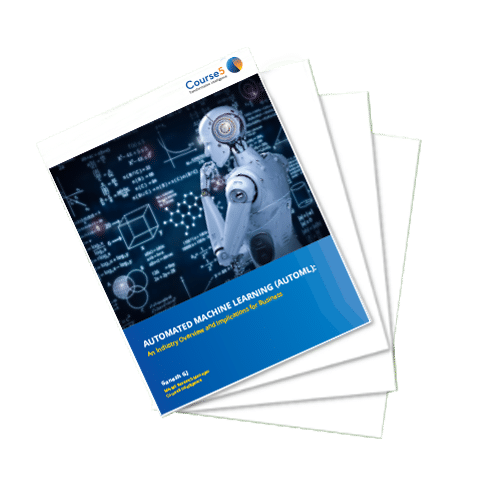Automated Machine Learning (AutoML): Breakthrough Technology to Accelerate Machine Learning Outcomes
By 2019, Machine Learning (ML) moved from a state of hype to having several tangible use cases, especially in the B2B space, resulting in increased customer trust and belief. ML has today become one of the most sought-after technologies across all industry verticals and horizontals. This switch has mainly occurred because of the increased availability of large sets of open data, hosts of ready-to-use algorithms, and freely available open-source programs. AI (Artificial Intelligence) and ML are becoming an indispensable part of any organization’s digital transformation journey.
The Growing Need for Automated Machine Learning
The traditional process of building a Machine Learning solution follows an iterative process that is resource-intensive and requires significant domain knowledge, and plenty of time to produce and compare dozens of models. The shortage of skilled data scientists and sample data for training has led to many failed long-term ML projects and a lack of adequate ROI in the ML industry.
Traditional ML automates a business process from a customer’s point of view, but the process of developing such ML models itself calls for large-scale automation due to the advent of connected devices, IoT, Big Data, and other emerging technologies. This automaton of developing ML models can be achieved through AutoML (Automated Machine Learning) which enables data scientists to generalize and automate some of the most difficult tasks like feature engineering, hyperparameter tuning, and other tasks involved in ML practices.
AutoML enables developers with limited machine learning expertise to train high-quality models specific to business needs without forcing them to go through the elaborate traditional ML workflow. The technology is expected to create a new class of ‘citizen data scientists (anyone who is familiar with Excel and has some kind of an affinity towards the data, but not necessarily a data scientist), placing the power of advanced ML directly in the hands of business users. With the application of AutoML, developers worldwide need not design new neural nets again and again for their particular needs, instead, they can just leverage the existing AutoML products by only making necessary modifications.
Automation: The Way Forward
AutoML is creating a diverse set of possibilities for marketers, enhancing Market Opportunity Analysis and enabling deeper customer engagement on a personal basis. Whether the business need is to empower data scientists/business users or to boost productivity, AutoML Market Analysis solutions are quickly becoming a must-have for every organization looking to scale up their use of ML.
Increasing demand for efficient fraud detection solutions, the growing need for personalized product recommendations, and the rising importance of predictive lead scoring are some of the key factors driving the growth of the market across the globe. APAC is expected to record the fastest growth during the forecast period.
AutoML Solutions: Evolving for Efficiency
In the past few years, there has been a surge of interest in AutoML tools. The current AutoML market is fragmented and still in the early stages, but has the potential to grow very rapidly. AutoML currently does not outperform hand-constructed models in many cases in terms of accuracy. Yet there is evidence that AutoML can achieve as much as 95% of the performance of the best-performing model. According to Forrester, every company that works on AI/ML will have a stand-alone AutoML tool in the near future. Furthermore, Gartner has also estimated that Enterprise AI will automate more than 40% of data science tasks by 2020.
In recent years, several off-the-shelf packages have been developed which provide automated machine learning. Many commercial organizations have also attempted to automate Machine learning which includes Auto-sklearn, Auto-Weka, Prodigy, H2O.ai’s Driverless AI, etc. Currently, startups like DataRobot, dotDATA, Edgeverve, etc. in the AutoML market are pushing to increase market awareness of AutoML products and are targeting citizen data scientists.
There are many AutoML solutions available on the cloud as well, with AWS Sagemaker being the most popular among all. With the growth of the cloud, Google Cloud’s AutoML and Microsoft Azure’s Machine Learning Service are also expected to see plenty of tangible use cases in the months to come.
Currently, there is no universally best AutoML approach and the currently available AutoML systems are still far from being able to solve many of the real-world data science problems, where the projects are multifaceted and involve complex and subjective tasks that do not lend themselves to easy automation. Another major problem that AutoML faces is that no single machine learning method performs best on all datasets, hence data scientists need to experiment with different methods for now. Also, there is a lack of transparency about why the model makes a particular recommendation, how the model is selected, etc.
However, AutoML solutions will evolve as platforms in the next three-to-five years automating more of the data science workflow and may be offered as AutoML-as-a-solution. With the application of AutoML, the data science role will increasingly become a business science role. Businesses have just begun to experiment with AutoML and are planning to apply it across some of their non-critical tasks and focus on the accuracy output level of the AutoML systems. Similar to Cloud Marketplace, there could be an AutoML marketplace in the future where ML users can just plug and play algorithms and run models based on the data they have. As the industry moves towards finding the best AutoML approaches, it requires practitioners and data scientists to provide feedback on the right tools to create a pathway towards a robust AutoML 2.0, where AutoML can be leveraged as an assistant tool that lowers dependency on highly skilled data scientists.

Read the Whitepaper on
AUTOMATED MACHINE LEARNING (AUTOML):
An Industry Overview and Implications for Business
How are companies like Disney, Facebook, and Huawei using AutoML? What are the applications of AutoML across industries like Healthcare, Retail, and Financial Services? Will AutoML change the role of Data Scientists?
Find out in this whitepaper.

Ganesh GJ
Ganesh GJ is a Market Research Manager at Course5 Intelligence. He has about 9 years of experience in bringing technology-driven automation and intelligence to market...Read More

Don’t miss our next article!
Sign up to get the latest perspectives on analytics, insights, and AI.






